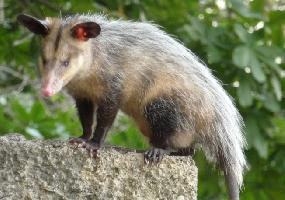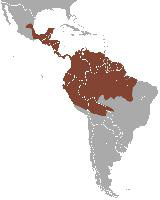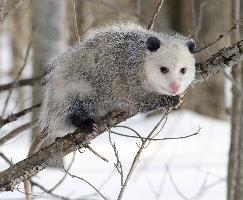
Animal description
The Common Opossum, scientifically known as Didelphis marsupialis, is a fascinating and versatile marsupial native to the Americas, particularly thriving from Mexico through Central America to parts of South America. This creature is among the most recognizable marsupials in the New World, thanks to its distinctive appearance and widespread distribution.Physically, the Common Opossum possesses a body structure that is well adapted to its omnivorous lifestyle. It has a robust body that measures about 13 to 37 inches in length, including its tail, which is about the same length as its body and acts as an additional limb for grasping and balancing. This prehensile tail is a hallmark of the species, providing an extraordinary level of agility and versatility in navigating its arboreal habitat. The animal's fur is generally grayish-white, with a stark white face and dark eyes surrounded by black patches, giving it a somewhat masked appearance.
One of the most intriguing aspects of the Common Opossum is its reproductive system, which is characteristic of marsupials. Females possess a pouch where the young, born in an extremely underdeveloped state, continue to grow and develop after birth. This pouch serves as a nurturing space where the offspring, typically numbering between 4 to 13, latch onto teats for nourishment and safety until they are mature enough to venture outside.
The diet of Didelphis marsupialis is remarkably varied, reflecting its adaptability to different environments. It is omnivorous, feeding on a wide range of items from fruits and insects to small vertebrates and even carrion. This dietary flexibility, combined with its nocturnal habits, makes the Common Opossum a successful forager and survivor in diverse ecosystems, including urban areas where it often comes into contact with human populations.
Behaviorally, the Common Opossum is known for its solitary and nomadic lifestyle, although it is not uncommon for their paths to cross, especially in areas rich in food resources. An interesting defense mechanism of this species is "playing possum," where the animal feigns death when threatened, emitting a foul smell from its anal glands to deter predators.
Despite its wide range and adaptability, the Common Opossum faces threats from habitat loss, hunting, and road accidents. However, it remains classified as Least Concern by the International Union for Conservation of Nature (IUCN), indicating that it is not currently at significant risk of extinction.
In conclusion, the Common Opossum (Didelphis marsupialis) is a remarkable creature that plays a vital role in the ecosystems of the Americas. Its unique physical and behavioral characteristics, combined with its adaptability, make it a fascinating subject of study and an important component of its native habitats.
Map of occurrence

Similar Animals
New photos of animals
Top 10 animals
- Dolphin gull (Leucophaeus scoresbii)
- Diana monkey (Cercopithecus diana)
- Moustached guenon (Cercopithecus cephus)
- Galápagos tortoise (Geochelone nigra complex)
- Japanese macaque (Macaca fuscata)
- Russian tortoise (Testudo horsfieldii)
- Stone loach (Barbatula barbatula)
- Greek tortoise (Testudo graeca)
- Common flying dragon (Draco volans)
- Vendace (Coregonus albula)
